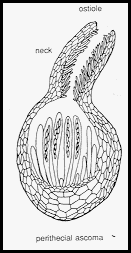
Class. Plectomycetes
 المؤلف:
اعداد المرجع الالكتروني للمعلوماتية
المؤلف:
اعداد المرجع الالكتروني للمعلوماتية
 المصدر:
almerja.com
المصدر:
almerja.com
 الجزء والصفحة:
الجزء والصفحة:
 17-11-2015
17-11-2015
 2697
2697
Class. Plectomycetes
Order: Eurtiales
This largely interesting cleistothecial order in which the conidial stage is much more prominent than the ascus stage which in most species is rarely seen. this order containing species of great economic importance.
Family: Eurotiaceae
These moulds are of considerable importance to us because they produce antibiotics and mycotoxins, and cause a lot of food spoilage.
Aspergillus:
have teleomorphs in Eurotium or Emericella,
penicillium
have teleomorphs in the rather similar Talaromyces or Eupenicillium.
The cleistothecial ascomata of the teleomorphs have impermeable walls one or more cells thick. The asci are scattered throughout the cavity of the ascoma ,they are spherical, thin-walled, and break down when the spores mature.
Class: Pyrenomycetes
The Pyrenomycetes or flask- fungi are numerous and show great variation in size and structure. The asci are enclosed in a flask- shaped perithecium opening to the outside by a narrow neck canal through which only one ascus can extend at a time. Individual perithecia are always small. In some genera they occur singly, while in others they are grouped together in a common stroma, which may be quiet large.

Order: Sphaeriales
Many members of this order produce dark, brittle, globose to pear-shaped individual perithecial ascomata with prominent ostioles. Others have many perithecial cavities immersed in a single stroma.
Family: Sordariaceae
This is a generally saprobic group producing solitary perithecial ascomata, and found on dung or decaying plant remains.
Sordaria sp.
Many species fruit on herbivore dung, the interior of the perithecium is occupied by hymenium of asci at all stages of development. In spore discharge one ascus, which happens to be a little a head of the rest, elongate up a narrow canal. Once the tip reaches the outside, the ascus bursts shooting the ascospores to distance of up to 10 cm. a few minutes usually elapsing between the discharge of successive asci
Melanosporaceae:
Chaetomium
is an important cellulolytic genus that damages fabrics and paper, especially in the tropics. It differs from the Sordaria in that its asci, though cylindrical, deliquesce or autolyse at maturity. Since they don't shoot their spores, and the mucilaginous, lemon-shaped ascospores ooze out of the ascoma into a characteristic mass of coiled or dichotomously branched hairs that develop on the top of the ascoma. Dispersal must be by rain or arthropods.
 الاكثر قراءة في الفطريات
الاكثر قراءة في الفطريات
 اخر الاخبار
اخر الاخبار
اخبار العتبة العباسية المقدسة


